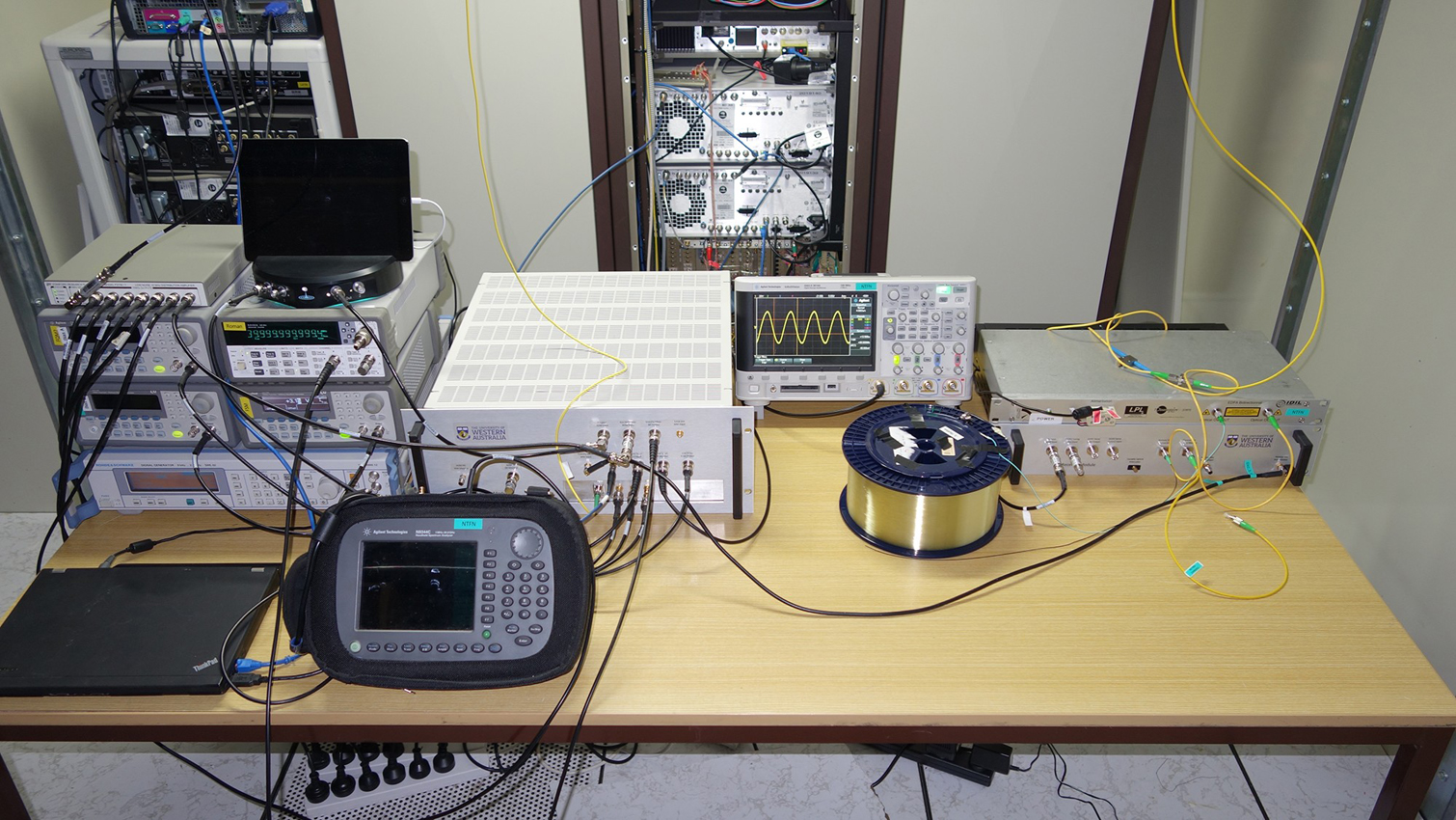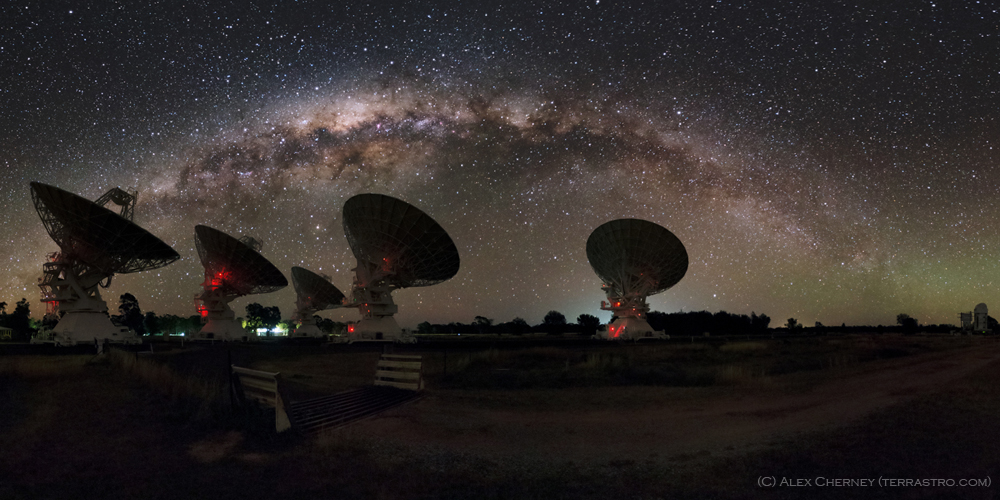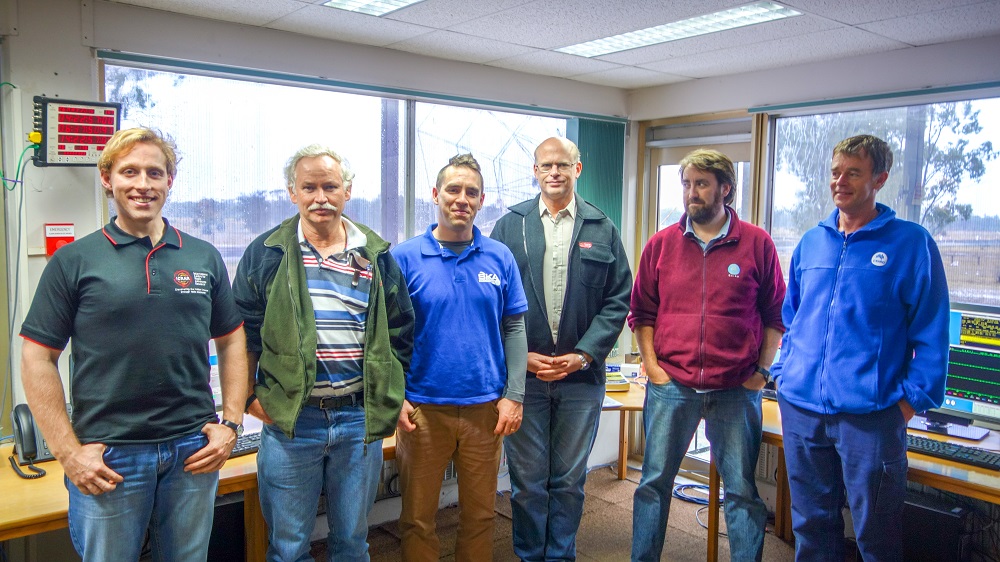Find out how our Australian researchers are developing a super-stable atomic clock to keep the Square Kilometre Array in sync.

Not exactly the type of clock you’d put on your bedside table, this is UWA’s prototype SKA frequency synchronisation system alongside ancillary equipment deployed in the ATCA’s correlator room. Image credit: Sascha Schediwy.
So, you think you can keep a beat? No matter how good your metronomic skills are, we bet it’s got nothing on this – a new, super-stable timing system developed by Australian researchers for the world’s largest radio telescope, the Square Kilometre Array (SKA).
The SKA will be made up of many antennas – some spread hundreds of kilometres apart. Radio signals received by the antennas are then transported along many kilometres of high speed optical fibre to a central location for processing. But along the way, fluctuations in the physical fibre may affect the stability of the transmitted signals.
To keep the SKA synchronised, the telescope will need a centrally-located atomic clock that transmits ultra-stable signals to each of the individual antennas, and a team from the International Centre for Radio Astronomy Research (ICRAR) have developed just that.
They call it a ‘frequency synchronisation system’. It continuously measures changes in the fibre link and applies a real-time correction that keeps the signals stable. The system needs to be extremely precise in order for the telescope to function, and it is – up to 100 times better than the requirements for the SKA, in fact. It’s so precise that the new timing system reduces signal fluctuations to one part in ten trillion, over a 1-second period.
Wait – what?
The team’s head researcher, Dr Schediwy explains, “A clock relying on a signal of that stability would only gain or lose a second after three million years.”
It’s all in the design
You’ve read about the SKA here before – the work we’re involved in to design components of the telescope like the dishes, the receivers, the infrastructure – not to mention our ASKAP telescope already operating on the future site of the SKA, in outback Western Australia.
But this is new, seriously breakthrough technology. And the team decided that our site in Narrabri, NSW – home to the Australian Telescope Compact Array – was the ideal location to conduct the verification trials.

Our ATCA telescope in Narrabri, NSW – the perfect place for the trials. Image credit: Alex Cherney (terrastro.com)
“Each of the six antennas [of the Compact Array] is equipped with two independent but identical receivers. The team could therefore connect our SKA synchronisation system to one set of receivers, while the other set remained unaltered,” said Dr Schediwy.
“This unique set-up enabled simultaneous observation of a reference galaxy in the sky using both the standard Compact Array reference system and UWA’s SKA synchronisation system, so a comparison of the astronomical data can be made to see if there are any differences between the established technology and our new system.”
“This success comes at an excellent time for the SKA project and our design, as the final decision on technology for the frequency stabilisation system will be made in the coming months.”
What happens next?
The research team from Perth’s International Centre for Radio Astronomy Research, The University of Western Australia School of Physics and our Astronomy and Space Science team tested their prototype equipment at our Australia Telescope Compact Array (ATCA) in Narrabri, NSW over a two-week period.

Members of the ICRAR/UWA-CSIRO team during the SKA Astronomical Verification trials at Narrabri L – R: David Gozzard, Mike Hill, Sascha Schediwy, Peter Mirtschin, Jamie Stevens, and Jock McFee. Image credit Marg McFee.
The new technology was invented as part of Australia’s involvement in the Signal and Data Transport (SaDT) Consortium. This group designs the hardware and software necessary for the transmission of data and information for the SKA across two telescope-wide networks.
With teams around the world working on new engineering solutions for the SKA, a final decision on technology for the ‘frequency stabilisation system’ will be made in the coming months.
Find out how we’re helping to build the Square Kilometre Array.


21st August 2019 at 12:12 pm
This is not the clock but the clock distribution and delta time equalization from what I can gather.
What is the clock source used to feed the fiber clock distribution system?
24th October 2019 at 4:28 pm
Hi Ron – The clock source is a hydrogen maser.
Hope this helps,
Kashmi
Team CSIRO